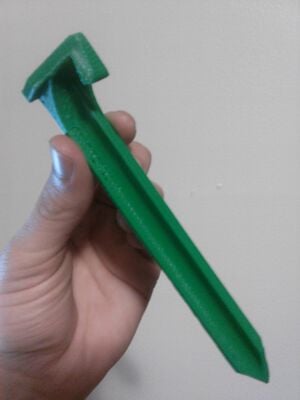
The idea behind this OSAT is very simple and nothing groundbreaking. A simple tent stake. To some it may not seem important or essential in any way but those that have pitched a canvas style structure know how valuable they can be. A tent stake doesn't have to hold up just a tent, it can be an anchor for many different kinds of shelters. That is why I thought this would be an appropriate OSAT project. Tent stakes are something used all over the world. They could be used to pitch a tent on a camping trip or to secure a medical tent in a small foreign town. This also brings up the issue of design flexibility to meet all these different use cases. There are, in fact, many different designs and styles for tent stakes already in existence. They mainly vary based on material but the environment in which the stake will be used is the second biggest factor. The ground in which the stake will be lodged could include any mixture of soil, sand, gravel, mud, or roots. The chosen style of stake works best in soil/roots but will be less effective in sand or large rocks.
For my design I chose a very common style for plastic tent stake but with some of my own personal changes from experience.
- I made the CAD model so that way it would print easily and the stresses common for a tent stake would not affect a 3D printed version.
- The stake head is slightly larger than most so the user can easily push it into the ground.
- The tip is sharp for cutting through roots and the shaft is strong to resist strain.
- The hook provides a larger recess to ensure that the rope/string will not come out even if the stake pulls out of the ground slightly (a common occurrence).
-
165mm length x 13mm shaft height
-
Large head and hook
Bill of Materials[edit | edit source]
- 3D Printer
- Tent Stake model
- PLA/ABS/or other appropriate filament
Here is a link to all source, stl, and gcode files http://www.thingiverse.com/thing:570448
Tools needed[edit | edit source]
- MOST Delta RepRap or similar RepRap 3-D printer
Skills and knowledge needed[edit | edit source]
- Basic knowledge for 3D printing with your printer of choice
Technical Specifications and Assembly Instructions[edit | edit source]
- Download files from link above
- Prepare printer and load.gcode file or slice the.stl how you like and then export a.gcode file
- Print, remove supports, clean up, and your all set!!
- Estimated print time: 1hr 20min (This is with 20% infill)
Common Problems and Solutions[edit | edit source]
Stake Weakness
- It is essential that the tent stake be printed near perfectly and with at least 20% fill to ensure proper strength
Cost savings[edit | edit source]
- Estimated costs
$0.25 per stake (purely the cost of the filament for printing)
- Commercial equivalent
- $ savings and % savings
Up to $0.50 per stake saved 66% savings
References[edit | edit source]
- My experience as a Boy Scout now Eagle Scout on many camping trips

